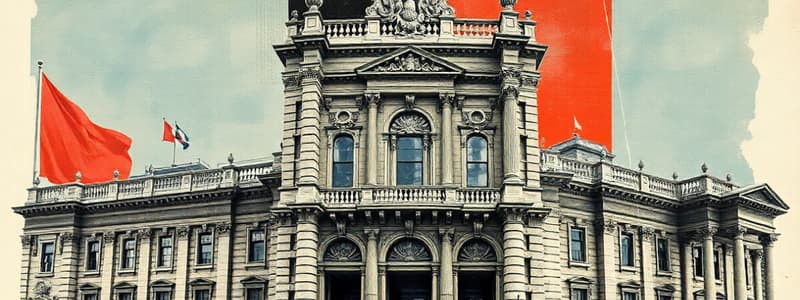Podcast
Questions and Answers
What does the International Style prioritize in architectural design?
What does the International Style prioritize in architectural design?
- Focus on volume and simplified surfaces (correct)
- Central symmetry in composition
- Use of intricate details and ornamentation
- Rejection of modern materials
Which principle is primarily associated with Functionalism in architecture?
Which principle is primarily associated with Functionalism in architecture?
- Aesthetic beauty is paramount
- Function dictates form (correct)
- Function supersedes decoration
- Form follows beauty
Who is a pioneer associated with the Functionalism architectural movement?
Who is a pioneer associated with the Functionalism architectural movement?
- Frank Lloyd Wright
- Tadao Ando
- Louis Kahn
- Le Corbusier (correct)
What is a key characteristic of Bauhaus architecture?
What is a key characteristic of Bauhaus architecture?
Which architectural movement aimed to blend functional aesthetics with modern technologies?
Which architectural movement aimed to blend functional aesthetics with modern technologies?
What is the literal translation of the term 'Bauhaus'?
What is the literal translation of the term 'Bauhaus'?
What aspect does the International Style reject in its architectural approach?
What aspect does the International Style reject in its architectural approach?
What material was commonly used in the development of Functionalism?
What material was commonly used in the development of Functionalism?
What is a defining characteristic of fascist architecture?
What is a defining characteristic of fascist architecture?
Which of the following statements best describes the intent behind the use of nationalist slogans in fascist architecture?
Which of the following statements best describes the intent behind the use of nationalist slogans in fascist architecture?
What architectural style emerged in the 1920s and 1930s that focused on functionality and rejected decorative elements?
What architectural style emerged in the 1920s and 1930s that focused on functionality and rejected decorative elements?
How did fascist architecture draw inspiration from ancient Rome?
How did fascist architecture draw inspiration from ancient Rome?
What significant impact did fascist architecture have on society?
What significant impact did fascist architecture have on society?
What was the initial design intention of the Facist Coliseum?
What was the initial design intention of the Facist Coliseum?
Which book is associated with the naming of the International Style?
Which book is associated with the naming of the International Style?
What was a common consequence of fascist architectural ideology?
What was a common consequence of fascist architectural ideology?
Flashcards
Functionalism Architecture
Functionalism Architecture
An architectural style that emerged in the early 20th century, emphasizing designing buildings with a focus on function.
International Style
International Style
An architectural movement that emphasizes the use of volumes over blocks, regularity over symmetry, and avoidance of excessive ornamentation.
Bauhaus Architecture
Bauhaus Architecture
One of the most influential design movements in modern architecture, it originated in Germany in 1919 and aimed to fuse craft and fine art.
Form Follows Function
Form Follows Function
Signup and view all the flashcards
Le Corbusier
Le Corbusier
Signup and view all the flashcards
Walter Gropius
Walter Gropius
Signup and view all the flashcards
Adolf Loos
Adolf Loos
Signup and view all the flashcards
Basic Geometrical Shapes
Basic Geometrical Shapes
Signup and view all the flashcards
What is Fascism?
What is Fascism?
Signup and view all the flashcards
Where did Fascism originate?
Where did Fascism originate?
Signup and view all the flashcards
What was the Facist Coliseum inspired by?
What was the Facist Coliseum inspired by?
Signup and view all the flashcards
What characteristics do Facist buildings have?
What characteristics do Facist buildings have?
Signup and view all the flashcards
What is the Facist Coliseum's unique architectural feature?
What is the Facist Coliseum's unique architectural feature?
Signup and view all the flashcards
What is the purpose of large public spaces in Facist architecture?
What is the purpose of large public spaces in Facist architecture?
Signup and view all the flashcards
Why does Facist architecture draw inspiration from ancient Roman architecture?
Why does Facist architecture draw inspiration from ancient Roman architecture?
Signup and view all the flashcards
Study Notes
Fascism Architecture
- Fascism is an authoritarian political system centered on extreme nationalism.
- Control over all aspects of life is a key feature.
- Originated in early 20th century Italy under Mussolini (1922).
- Similar systems emerged in other countries.
- Characteristics include propaganda, opposition suppression, nationalistic slogans, and idolization of leaders/military.
- Led to significant wars and suffering, such as WWII.
- Architecture emphasized large, imposing structures reflecting state power (government buildings, public squares).
- Simple, clear decoration focused on clean geometrical shapes and classical elements (columns, arches).
- Aiming for societal unity through large public spaces encouraging gatherings and national events.
- The Colosseum-inspired "Square Colosseum" design sought to represent Roman grandeur.
- Features include multi-layered terraces/arches, initially planned differently than the final design (6 rows of 9 arches, initially conceived as 8 rows of 13).
- Inspiration from ancient Roman architecture emphasizing historical greatness and national identity.
International Style Architecture
- A 1920s-1930s architectural style.
- Features a lack of regional characteristics.
- Emphases functionality and rejects decorative elements.
- Typically associated with modernism before WWII.
- Origins include a book by Hitchcock & Russell and architect Philip Johnson's coverage of the 1932 MoMA exhibit.
- Globally simultaneous appearance.
- Key features involve novel approaches to volume.
- Embraces simplified, regular forms and surfaces over massive blocks.
- Prefers organizational systematization over precise axial symmetry.
- Emphasizes relations between structural elements and precise definition of columns.
- Avoidance of embellishment for structural considerations.
Functionalism Architecture
- An architectural trend emerging in the early 20th century, emphasizing the correspondence between building form and function.
- Heavily influenced by Louis Sullivan's "form follows function" principle.
- Rose during industrial movements, with extensive use of steel and glass for efficiency.
- Influenced by modernist design (simple, unadorned), Constructivism (clear industrial design), and the Bauhaus movement (combining functional aesthetics and modern technology).
- Notable figures include Le Corbusier ("house as a machine for living"), Walter Gropius (founder of the Bauhaus), and Adolf Loos (proponent of minimal decoration).
- Seagram Building is a prominent example (1930-1945/1960-present).
- Central to this function is the principle that form is subordinated to the building's practical function.
Bauhaus Architecture
- The Bauhaus was a design school in Germany.
- Aimed to fuse art and crafts.
- Originating in Weimar, Germany, transitioning to Dessau (1925) and Berlin.
- Focused on essential geometric forms (circles, squares, triangles) minimizing embellishment (eliminating elaborate ornament common in pre-20th Century European art.)
- Relied on basic colors (red, blue, yellow, black, and white).
- Promoted unconventional, non-centralized/non-symmetrical layouts in facades.
- The school's closing in 1933 due to Nazi influence led to emigration, primarily to the USA, broadening its influence.
- Key figures include Walter Gropius (the school's founder).
Russian Constructivism
- A movement flourishing in early 20th century Russia.
- Characteristics include flowing lines, free-form configurations, and symbolic meanings embedded in buildings.
- Emphasizes dynamism with continuous, non-linear designs, sculptural-like configurations, and free spatial formations.
- Illustrative examples include Tatlin's Tower (symbolic monument to global communism, with offices, telegraph units, restaurants, meeting halls). It was a design concept, not fully constructed.
Studying That Suits You
Use AI to generate personalized quizzes and flashcards to suit your learning preferences.




